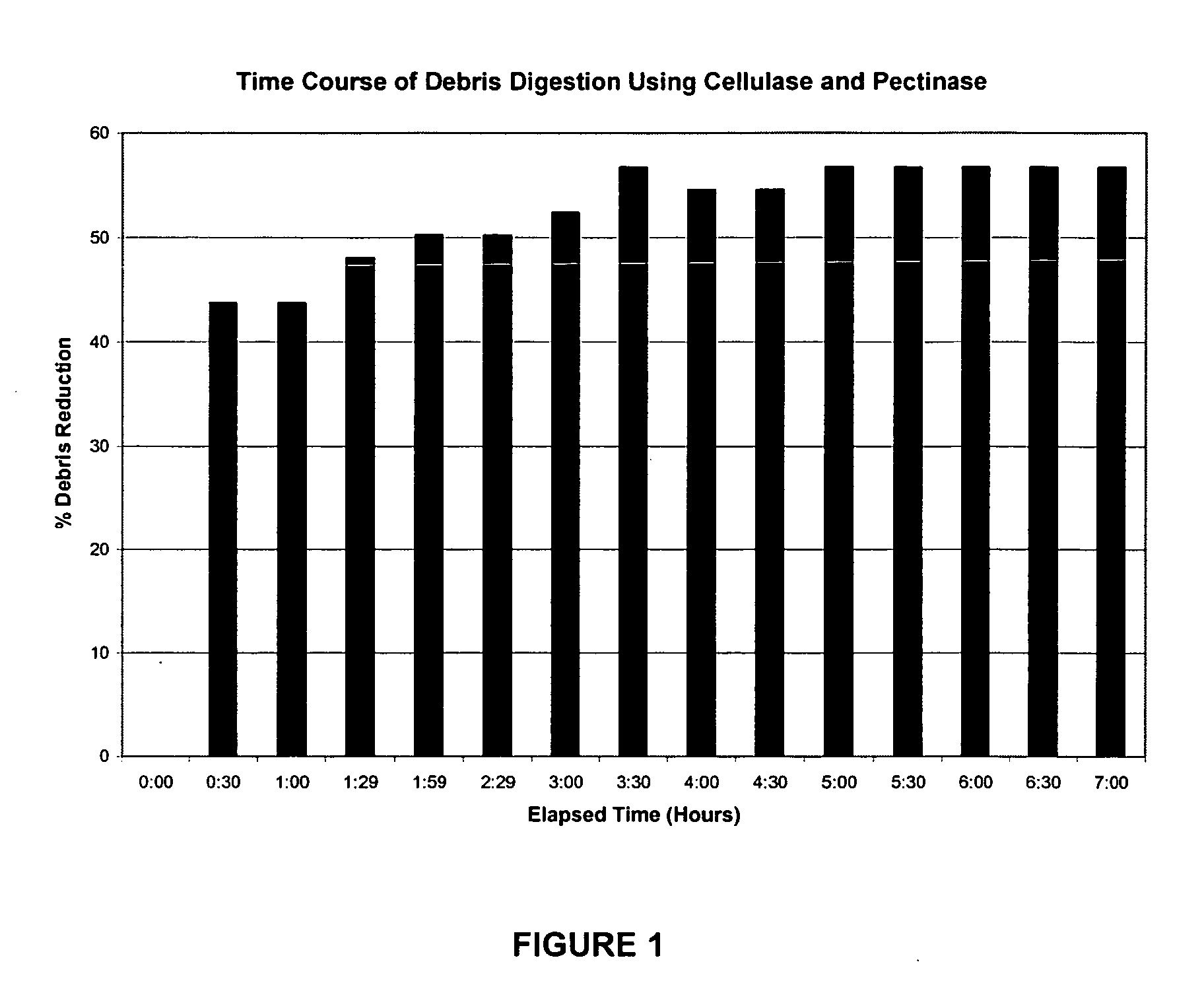Method of purifying oocysts using enzymatic digestion of fecal debris
a technology of oocysts and fecal debris, which is applied in the field of purification of protozoan oocysts, can solve the problems of proportionately reducing the scale of operation for all downstream processes, and achieve the effects of reducing the amount of solids, reducing the amount of fecal material, and reducing the load of fecal cells
- Summary
- Abstract
- Description
- Claims
- Application Information
AI Technical Summary
Benefits of technology
Problems solved by technology
Method used
Image
Examples
example 1
Enzyme Tests
[0081] An initial experiment was performed to test the feasibility of using digestive enzymes to purify Eimeria oocysts. E. maxima oocysts were produced in broilers. Feces containing oocysts were collected 5 to 8 days post-inoculation into an antimicrobial solution consisting of 10% citric acid, 0.75 to 3% hydrogen peroxide, and 0.25% propionic acid. Materials were sieved to remove large debris and sporulated in 10% citric acid, 0.75 to 3% hydrogen peroxide, and 0.25% propionic acid with stirring and aeration for at least 48 h. A sample of material was taken after sporulation and subjected to various enzyme treatments (see Table 1). Enzymes (cellulase and amylase) were obtained from two commercial sources (Novozymes and Genencor) for use in this experiment. Enzymes were added at 20% (v / v) to each preparation. The pH of the sample was adjusted to approximately pH 4.5 for cellulase treatment or cellulase+amylase treatment and to pH 7.0 for amylase treatment alone. Materia...
example 2
Multi-Enzyme Experiments I:
Studies Using Fecal Solids From Which Oocysts Had Been Removed
[0084] Broiler birds were infected with E. maxima oocysts, and the oocyst-containing feces were collected 5 to 8 days post infection. Feces were collected into 10% citric acid, 0.75 to 3% hydrogen peroxide, and 0.25% propionic acid. The suspension was sieved to remove large particles, and oocysts were sporulated for at least 48 h in 10% citric acid, 0.75 to 3% hydrogen peroxide, and 0.25% propionic acid with stirring and aeration. Following sporulation, the suspension was centrifuged to pellet the oocysts and fecal debris, and the supernatant was discarded. The pellet was resuspended in magnesium sulfate flotation solution adjusted to a density of 1.2 g / mL and centrifuged at 1800×g for approximately 10 min. Oocysts, contained in the supernatant, were diluted with water and processed further for use in other experiments. The remaining pelleted material, which represented the undigested fecal ma...
example 3
Multi-Enzyme Experiments II:
Studies Using Fecal Material Containing Eimeria Oocysts
[0090] Broiler chickens were inoculated with any of E. acervulina, E. maxima, or E. tenella oocysts. Feces containing oocysts were collected during the peak oocyst output period for each species. Feces were collected into an antimicrobial solution consisting of 10% citric acid, approximately 0.75 to 3% hydrogen peroxide, and 0.25% propionic acid. The samples were sieved to remove large debris particles and centrifuged to pellet the debris.
[0091] Three replicate samples, each consisting of 5 mL pelleted solids resuspended in PBS pH 5.0 served as controls for each treatment. Three replicate samples per enzyme treatment were prepared. Samples were resuspended in either 20% cellulase solution or 20% cellulase with 4% pectinase in PBS pH 5.0 and incubated at room temperature with gentle agitation for at least 4 h. Oocysts were enumerated in control and treatment samples using the McMasters method, and s...
PUM
| Property | Measurement | Unit |
|---|---|---|
| temperature | aaaaa | aaaaa |
| temperature | aaaaa | aaaaa |
| pH | aaaaa | aaaaa |
Abstract
Description
Claims
Application Information
 Login to View More
Login to View More - R&D
- Intellectual Property
- Life Sciences
- Materials
- Tech Scout
- Unparalleled Data Quality
- Higher Quality Content
- 60% Fewer Hallucinations
Browse by: Latest US Patents, China's latest patents, Technical Efficacy Thesaurus, Application Domain, Technology Topic, Popular Technical Reports.
© 2025 PatSnap. All rights reserved.Legal|Privacy policy|Modern Slavery Act Transparency Statement|Sitemap|About US| Contact US: help@patsnap.com

